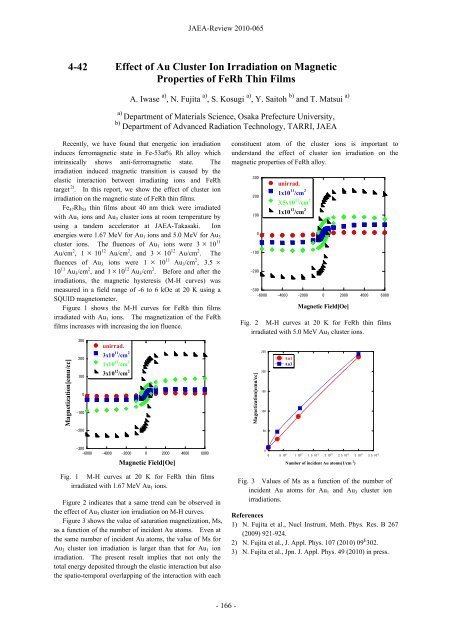JAEA-Review-2010-065.pdf:15.99MB - 日本原子力研究開発機構
JAEA-Review-2010-065.pdf:15.99MB - 日本原子力研究開発機構
JAEA-Review-2010-065.pdf:15.99MB - 日本原子力研究開発機構
You also want an ePaper? Increase the reach of your titles
YUMPU automatically turns print PDFs into web optimized ePapers that Google loves.
Effect of Au Cluster Ion Irradiation on Magnetic<br />
Properties of FeRh Thin Films<br />
A. Iwase a) , N. Fujita a) , S. Kosugi a) , Y. Saitoh b) and T. Matsui a)<br />
a) Department of Materials Science, Osaka Prefecture University,<br />
b) Department of Advanced Radiation Technology, TARRI, <strong>JAEA</strong><br />
Recently, we have found that energetic ion irradiation<br />
induces ferromagnetic state in Fe-53at% Rh alloy which<br />
intrinsically shows anti-ferromagnetic state. The<br />
irradiation induced magnetic transition is caused by the<br />
elastic interaction between irradiating ions and FeRh<br />
target 2) . In this report, we show the effect of cluster ion<br />
irradiation on the magnetic state of FeRh thin films.<br />
Fe 47Rh 53 thin films about 40 nm thick were irradiated<br />
with Au 1 ions and Au 3 cluster ions at room temperature by<br />
using a tandem accelerator at <strong>JAEA</strong>-Takasaki. Ion<br />
energies were 1.67 MeV for Au 1 ions and 5.0 MeV for Au 3<br />
cluster ions. The fluences of Au 1 ions were 3 × 10 11<br />
Au/cm 2 , 1 × 10 12 Au/cm 2 , and 3 × 10 12 Au/cm 2 . The<br />
fluences of Au 3 ions were 1 × 10 11 Au 3/cm 2 , 3.5 ×<br />
10 11 Au 3/cm 2 , and 1 × 10 12 Au 3/cm 2 . Before and after the<br />
irradiations, the magnetic hysteresis (M-H curves) was<br />
measured in a field range of -6 to 6 kOe at 20 K using a<br />
SQUID magnetometer.<br />
Figure 1 shows the M-H curves for FeRh thin films<br />
irradiated with Au 1 ions. The magnetization of the FeRh<br />
films increases with increasing the ion fluence.<br />
Magnetization[emu/cc]<br />
4-42<br />
300<br />
200<br />
100<br />
0<br />
-100<br />
-200<br />
unirrad.<br />
3x10 11 /cm 2<br />
1x10 12 /cm 2<br />
3x10 12 /cm 2<br />
-300<br />
-6000 -4000 -2000 0 2000 4000 6000<br />
Magnetic Field[Oe]<br />
Fig. 1 M-H curves at 20 K for FeRh thin films<br />
irradiated with 1.67 MeV Au 1 ions.<br />
Figure 2 indicates that a same trend can be observed in<br />
the effect of Au 3 cluster ion irradiation on M-H curves.<br />
Figure 3 shows the value of saturation magnetization, Ms,<br />
as a function of the number of incident Au atoms. Even at<br />
the same number of incident Au atoms, the value of Ms for<br />
Au 3 cluster ion irradiation is larger than that for Au 1 ion<br />
irradiation. The present result implies that not only the<br />
total energy deposited through the elastic interaction but also<br />
the spatio-temporal overlapping of the interaction with each<br />
<strong>JAEA</strong>-<strong>Review</strong> <strong>2010</strong>-065<br />
- 166 -<br />
constituent atom of the cluster ions is important to<br />
understand the effect of cluster ion irradiation on the<br />
magnetic properties of FeRh alloy.<br />
300<br />
200<br />
100<br />
0<br />
-100<br />
-200<br />
-300<br />
-6000 -4000 -2000 0 2000 4000 6000<br />
Magnetization[emu/cc]<br />
250<br />
200<br />
150<br />
100<br />
50<br />
0<br />
unirrad.<br />
1x10 11 /cm 2<br />
0 5 10 11<br />
3.5x10 11 /cm 2<br />
1x10 12 /cm 2<br />
Au1<br />
Au3<br />
Magnetic Field[Oe]<br />
Fig. 2 M-H curves at 20 K for FeRh thin films<br />
irradiated with 5.0 MeV Au 3 cluster ions.<br />
1 10 12<br />
1.5 10 12<br />
Fig. 3 Values of Ms as a function of the number of<br />
incident Au atoms for Au 1 and Au 3 cluster ion<br />
irradiations.<br />
References<br />
1) N. Fujita et al., Nucl Instrum. Meth. Phys. Res. B 267<br />
(2009) 921-924.<br />
2) N. Fujita et al., J. Appl. Phys. 107 (<strong>2010</strong>) 09 E 302.<br />
3) N. Fujita et al., Jpn. J. Appl. Phys. 49 (<strong>2010</strong>) in press.<br />
2 10 12<br />
2.5 10 12<br />
Number of incident Au atoms(1/cm 2 )<br />
3 10 12<br />
3.5 10 12

















